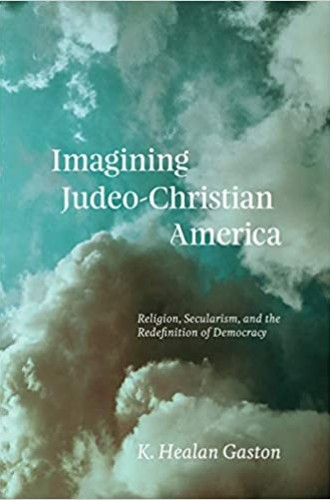How the dream of a Judeo-Christian America shaped the culture wars
Healan Gaston excavates a label that has both divided and united us.
“Whatever we once were,” then senator Barack Obama declared in 2006, “we are no longer just a Christian nation; we are also a Jewish nation, a Muslim nation, a Buddhist nation, a Hindu nation, and a nation of nonbelievers.” The statement was both descriptive and aspirational. Because the United States has many varieties of Christianity and many religious minorities, Obama argued, democracy demands that “the religiously motivated translate their concerns into universal, rather than religion-specific, values.” Democracy itself unites Americans of all faiths and those of no faith.
Obama’s invocation of both religious diversity and democracy resonated with many Americans, but it also met with pushback. During the 2008 campaign, John McCain gingerly but repeatedly described the United States as a “Christian nation.” In the years that followed, conservative Christians sought a political savior who would preserve freedoms they insisted were under assault.
Read our latest issue or browse back issues.
What were we? What are we? How do we “dream” the landscape of American religion? asks K. Healan Gaston. Terms such as Christian, multireligious, and secular are at once descriptive, aspirational, and even coercive. Gaston excavates the history of one such dream, that of a Judeo-Christian America.
The term Judeo-Christian first gained broad currency in the 1930s, when educators, theologians, and scholars used it to differentiate the democratic West from both the Nazi and Soviet forms of totalitarianism. Today, Americans who have any knowledge of the construct tend to associate it with a midcentury movement of inclusion, with a “tri-faith America” in which Protestants finally extended toleration to Catholics and Jews.
The story is not nearly so simple and sunny, Gaston argues. The “loose consensus that began to form around the idea of a ‘Judeo-Christian tradition’ . . . masked profound and deeply political divisions.” Gaston divides Americans who embraced the label into two rough camps, “pluralists” and “exceptionalists.”
When pluralists spoke of Judeo-Christian America, they leaned on civic definitions of American identity, definitions that stressed a commitment to a shared set of democratic assumptions and values. Pluralists used the term not to suggest that only Christians and Jews could be good Americans but as a shorthand way of inviting religious minorities and even nonbelievers into the public sphere.
The exceptionalists, by contrast, argued that American democracy would perish “unless its citizens hewed to certain modes of Christian and Jewish faith.” Few Jews found any version of Judeo-Christian rhetoric attractive, but they especially recoiled at exceptionalist critiques of secularism and attempts to undermine the separation of church and state. Jews knew that many Americans lauded “Judeo-Christian values” while working to make the public sphere more explicitly Christian and Protestant, not more inclusive. Indeed, many Protestant defenders of the “Judeo-Christian civilization” spoke disparagingly about Judaism and expressed hopes that Jews would come to their senses and convert to Christianity.
Still, the idea of Judeo-Christian America flowered during and after the Second World War. Reinhold Niebuhr and Will Herberg rarely used the exact term, but they popularized the idea that only explicit and vigorous formulations of Christianity and Judaism could underpin democracy against “godless” communism. As the Vatican made peace with religious diversity and the separation of church and state, increasing numbers of Catholic leaders found the idea of tri-faith America useful, especially when Protestants joined them in denouncing Supreme Court decisions that held school-led prayer and Bible reading unconstitutional.
By the mid-1960s, the fragile consensus about Judeo-Christian America broke down. Pluralists now found the constraints of Judeo-Christianity far too narrow, and they defended the place of other religious minorities and nonbelievers in American civic life. As pluralists abandoned the phrase, exceptionalists waved the Judeo-Christian banner all the more fervently.
The term was especially useful to Republican politicians courting the votes of evangelicals. In August 1980, Ronald Reagan made a campaign stop at the National Affairs Briefing, addressing an audience of 15,000 conservative Protestants. “Traditional Judeo-Christian values based on the moral teaching of religion,” Reagan warned, “are undergoing what is perhaps their most serious challenge in our nation’s history.” As Gaston notes, no president employed the rhetoric of Judeo-Christianity more frequently than Reagan. It lent a veneer of inclusivity to his courtship of evangelical voters. “I know that you can’t endorse me,” he quipped at the National Affairs Briefing, “but . . . I want you to know that I endorse you.” (Gaston might have included the irony that Southern Baptist leader Bailey Smith told the same gathering that “God Almighty does not hear the prayer of a Jew.”)
By the 21st century, the idea of Judeo-Christian America was confined to one part of the American political spectrum. Less artfully than Reagan, but no less effectively, Donald Trump blended Judeo-Christian rhetoric with pandering to evangelicals. “We are stopping cold the attacks on Judeo-Christian values,” President Trump told the Values Voter Summit in 2017. “We’re saying ‘Merry Christmas’ again.” Forget Hanukkah.
Gaston presses us to contemplate fundamental questions about American identity and democracy. Can Americans “know who they are . . . without delineating who they are not?” She doesn’t provide definitive answers to such thorny questions, but she rightly warns us to ask how our “fears and hatreds” shape the way we describe the United States. “In the future, as in the past,” Gaston concludes, “our dreams of America will powerfully shape our language and our actions alike.”
Dreams or nightmares? January 2021 provided a window into some of those fears and hatreds, a toxic mixture of misogyny and White supremacy rooted in the culture wars of the past several decades. With right-wing insurrectionists pledging their allegiance to both Donald Trump and Jesus Christ while engaging in mass violence, the Cold War–era idea that secular Americans threatened American democracy seems laughable today.
Gaston’s book serves as both a patient prehistory of this moment and a necessary caution. Unity is elusive. All labels divide. Inevitably, some groups—fairly or unfairly—feel unwelcome in the public sphere. While Christian nationalists represent a clear threat to democracy, the overwhelming majority of conservative Protestants do not. All Americans are prone to project their fears and hatreds onto others.
We sorely need religious and political leaders to seek common ground with all Americans—regardless of beliefs and practices, regardless of party and policies—who are committed to democracy and our constitutional order. That process isn’t sacred, but it is still our best civic hope, something to keep dreaming for.
A version of this article appears in the print edition under the title “A Judeo-Christian nation?”






